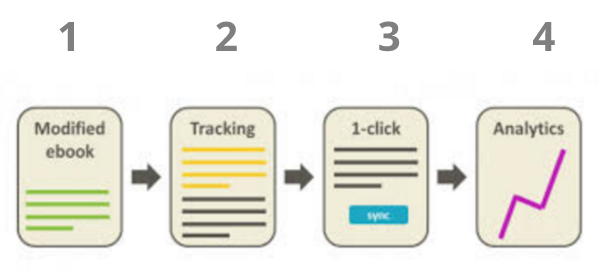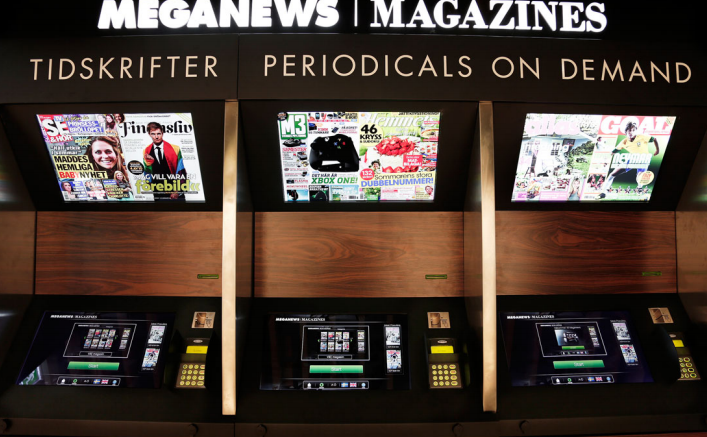In the last couple of years, sale numbers for publishing houses have decreased. Publishing houses are being confronted by many new challenges because of new types of media consumers are using nowadays. Decreasing sales have forced the publishing houses to think of other ways to get their products to their custumers. Consequently, there are some unique projects that have been developed by publishers and companies to catch readers’ attention, three of which are discussed in this article.
Jellybooks
Let’s start with Jellybooks, a company that collects data from eBook test readers.
![]()
In order to gather consumer information, the publishing house chooses a book and buys an analytic campaign from Jellybooks for the eBook. Jellybooks then adds their software into the eBook before it’s sent out to the test readers, who are chosen according to the publishing house’s target group research. Once the readers download their copy of the book onto their device and begin reading, Jellybooks starts to collect data; the reader just has to click a button at the end of every chapter to send their reading statistics. The collected data records the total time it takes to read the book, the time spent on each chapter, and if the book was interrupted or unfinished. The process helps identify weak spots in the story by showing how long readers take to get through a chapter as well as if they tend to abandon the book completely at a certain point. After six to eight weeks, when the campaign has run its course, Jellybooks analyzes the data and creates graphs and visuals in order to make the data more useful and accessible. It also asks the readers for feedback on the book and lets them decide between different covers. Jellybooks helps publishing houses become more familiar with their target groups and figure out whether or not it is profitable to send books through to print production.

Despite all the great information collected, Jellybooks has its downsides. It is expensive to evaluate multiple books, since you can only buy one campaign for one book at a time and each campaign costs a few hundred dollars. The publishing house also needs to pick out their own test readers and the results rely completely on their willingness to give feedback. Readers have a chance to press the „Send Data“ button after every chapter manually, but if they don’t click the button, there’s no data to be collected for that chapter. Sending free eBooks out to test readers can also be a risky move, since publishing houses are essentially giving away their product without a guaranteed returned benefit.
Onb the positive side, though, Jellybooks is the only company to analyze and present data to publishing houses thus far. Amazon, Google and others are collecting data from eBook consumption, but they don’t share it with the publishers.
Meganews
Meganews is a special form of print on demand (POD). Most people are familiar with this type of printing in regards to books, but have never heard of it in the context of newspapers or magazines—this is where Meganews comes in. It’s a vending machine where the customer is able to browse through different kind of magazines, select the one they want, and have it printed immediately. The printed products aren’t any more expensive than the ones for sale in a regular shop, but it will save the publisher the costs of overproduction for certain products and, therefore, will keep the publisher from wasting money on a too-large run of the product because every printed copy is actually sold. It also decreases costs for logistics and distribution, saves paper, is eco-friendly and can be updated daily via the internet server where the magazine PDF files are stored.

The Meganews vending machine is not prevalent on the market now but it holds great potential for places with a heavy flow of people (such as hotels, trainstations, airports …). It is able to provice a customer with their usual newspaper from home no matter where they may be. Since the customer can browse through the 200 options, he or she is almost certain to find something that interests them.
On the other hand, there are some drawbacks to this machine as well. Not only is the quality not as high as other printing methods, but some of the customers won’t want to wait for the magazine to be printed, which takes approximately two minutes, and there isn’t an option to have magazines be preprinted in case someone is in a hurry or if there’s a mistake. The only form of payment that is accepted is credit card, which isn’t available for everyone.
Oetinger 34
Oetinger 34 is a platform introduced by the publishing house Oetinger. The site is a place where young aspiring authors, illustrators and editors can come together to create books, which can be proofread by other members of the platform. The users are able to vote for books they like, which can then be sent to the publishing house Oetinger and can be officially published, either in print or digitally. Oetinger 34 is not open for everyone, you need to apply and be selected to join. The work is viewed by this small community only, but everyone is qualified to some degree.
The platform is a chance for both the publishing house and the people working on the books to interact in a way that was not possible before. Oetinger is presented with new ideas and storytelling styles while the members are mentored by their fellow creators and have an opportunity to practice their skills while getting help and support from the community. Oetinger 34 also offers professional workshops to improve members’ skills and help them connect with other creators. It still holds the risk that your idea might be stolen since no one can guarantee for the safety of your creation.
Overall, there doesn’t seem to be a perfect solution for the modern day publishing company, but there are some good options out there to help connect with customers in a new way.
by Maria Beerboom, Anna Donnerstag, Michelle Jehle, Annika Miller, Rebecca Notter
Image source:
Sources:
https://www.saint-elmos.com/de/blog/details/article/oetinger-34/

